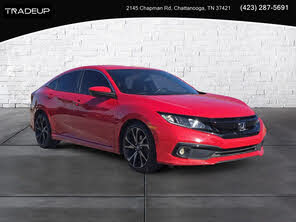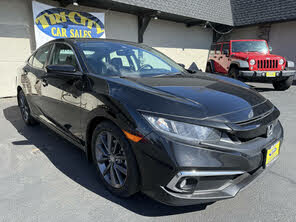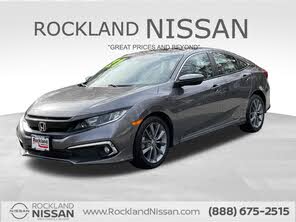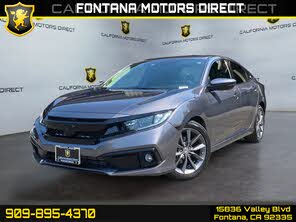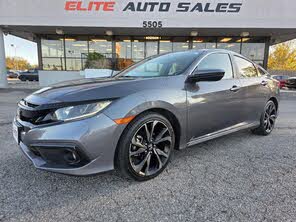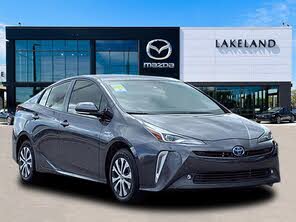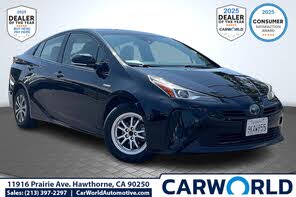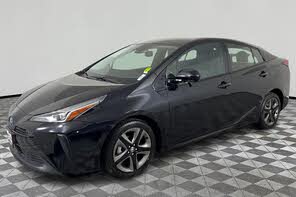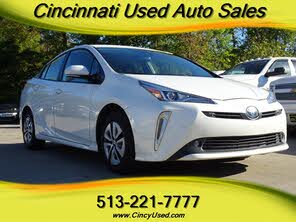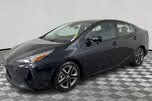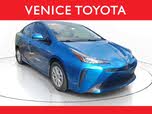2021 Honda Civic vs 2020 Toyota Prius
Overview | |
MSRP$24,325 | MSRP$21,250 |
Listings132 | Listings739 |
Ratings & Reviews | |
User Reviews | User Reviews |
Expert reviews7.5 out of 10 | Expert reviews7.2 out of 10 |
Pros
Cons
| Pros
Cons
|
2020 Toyota Prius Reviews SummaryEver heard of an eponym? It’s a brand or product that is so popular that it’s come to define its respective market. Think of Kleenex for tissues or Band-Aid for medical bandages. For hybrids, the Toyota Prius has ascended to near-eponym status. It was one of the first—and remains one of the most popular—hybrids ever made. As automakers across the industry are rolling out more hybrid models, the Prius continues to be the standard-bearer of this genre. This is largely due to the fact that the Prius is a dedicated hybrid, rather than a hybrid variant of an existing model. Throughout the industry, different companies are taking different approaches to alt-fuel vehicles, including full-electric and hydrogen fuel cell powertrains. The Prius endures as the leader in hybrid power due to a focus on fuel efficiency that doesn’t compromise on style, drivability, and versatility. So how does the Prius hold its ground as more players enter the fray? Read on to find out. | |
2021 Honda Civic Reviews SummaryHonda is ready to retire the 10th-generation Civic, one of the groundbreaking versions in the nameplate's long and storied history. From its polarizing design and three body styles to the arrival (finally!) of the Type R performance variant in the U.S. market, this version of the Civic made its mark. And even though the design is now six years old, and the car is ubiquitous on American roads, the 2021 Honda Civic remains worthy of consideration. | |
No video found | No video found |
Popular Features & Specs | |
Engine1.8L 121 hp I4 Hybrid | Engine2.0L 158 hp I4 |
Drive TrainFWD | Drive TrainFWD |
Seating Capacity5 | Seating Capacity5 |
Horsepower | Horsepower158 hp @ 6500 rpm |
EV Battery Capacity0.7 kWh | EV Battery Capacity |
MPG City58 | MPG City30 |
MPG Highway53 | MPG Highway38 |
Engine | |
Engine Name1.8L 121 hp I4 Hybrid | Engine Name2.0L 158 hp I4 |
Torque | Torque138 lb-ft @ 4200 rpm |
Horsepower | Horsepower158 hp @ 6500 rpm |
DrivetrainFWD | DrivetrainFWD |
Fuel Economy | |
EV Battery Capacity0.7 kWh | EV Battery Capacity |
MPG City58 | MPG City30 |
MPG Highway53 | MPG Highway38 |
Interior | |
Seating Capacity5 | Seating Capacity5 |
Safety | |
Front Crash Overall4 | Front Crash Overall5 |
Side Crash Overall5 | Side Crash Overall5 |
Dimensions & Capacity | |
Cargo Space27.4 cu ft | Cargo Space15.1 cu ft |
Curb Weight3010 lbs | Curb Weight2771 lbs |
Height57.9 in | Height55.7 in |
Length180.0 in | Length182.7 in |
Width69.3 in | Width70.9 in |
Wheelbase106.3 in | Wheelbase106.3 in |
Maximum Payload825 lbs | Maximum Payload998 lbs |
Number of doors4 | Number of doors4 |
Overview | ||
MSRP | $24,325 | $21,250 |
Listings | ||
Ratings & Reviews | ||
User reviews | ||
Expert reviews | 7.5 out of 10Read full review | 7.2 out of 10Read full review |
Pros & cons | Pros
Cons
| Pros
Cons
|
Summary | Ever heard of an eponym? It’s a brand or product that is so popular that it’s come to define its respective market. Think of Kleenex for tissues or Band-Aid for medical bandages. For hybrids, the Toyota Prius has ascended to near-eponym status. It was one of the first—and remains one of the most popular—hybrids ever made. As automakers across the industry are rolling out more hybrid models, the Prius continues to be the standard-bearer of this genre. This is largely due to the fact that the Prius is a dedicated hybrid, rather than a hybrid variant of an existing model. Throughout the industry, different companies are taking different approaches to alt-fuel vehicles, including full-electric and hydrogen fuel cell powertrains. The Prius endures as the leader in hybrid power due to a focus on fuel efficiency that doesn’t compromise on style, drivability, and versatility. So how does the Prius hold its ground as more players enter the fray? Read on to find out. | Honda is ready to retire the 10th-generation Civic, one of the groundbreaking versions in the nameplate's long and storied history. From its polarizing design and three body styles to the arrival (finally!) of the Type R performance variant in the U.S. market, this version of the Civic made its mark. And even though the design is now six years old, and the car is ubiquitous on American roads, the 2021 Honda Civic remains worthy of consideration. |
Video | No video found | No video found |
Popular Features & Specs | ||
Engine | 1.8L 121 hp I4 Hybrid | 2.0L 158 hp I4 |
Drive Train | FWD | FWD |
Seating Capacity | 5 | 5 |
Horsepower | 158 hp @ 6500 rpm | |
EV Battery Capacity | 0.7 kWh | |
MPG City | 58 | 30 |
MPG Highway | 53 | 38 |
Engine | ||
Engine Name | 1.8L 121 hp I4 Hybrid | 2.0L 158 hp I4 |
Torque | 138 lb-ft @ 4200 rpm | |
Horsepower | 158 hp @ 6500 rpm | |
Drivetrain | FWD | FWD |
Fuel Economy | ||
EV Battery Capacity | 0.7 kWh | |
MPG City | 58 | 30 |
MPG Highway | 53 | 38 |
Interior | ||
Seating Capacity | 5 | 5 |
Safety | ||
Front Crash Overall | 4 | 5 |
Side Crash Overall | 5 | 5 |
Dimensions & Capacity | ||
Cargo Space | 27.4 cu ft | 15.1 cu ft |
Curb Weight | 3010 lbs | 2771 lbs |
Height | 57.9 in | 55.7 in |
Length | 180.0 in | 182.7 in |
Width | 69.3 in | 70.9 in |
Wheelbase | 106.3 in | 106.3 in |
Maximum Payload | 825 lbs | 998 lbs |
Number of doors | 4 | 4 |
The 2020 Toyota Prius retained its iconic jellybean-like shape, a design optimized for aerodynamics since its second generation. Toyota made subtle tweaks to give it a more sedan-like appearance while maintaining its hatchback functionality. The Prius continued to look contemporary with its futuristic style, even as the rest of the industry caught up with its design cues. Inside, the Prius featured a unique cabin layout with centrally located instrumentation and gauges, a hallmark of its design for over two decades. The trim levels ranged from the entry-level L Eco to the top-tier Limited, each adding more features and luxury.
In contrast, the 2021 Honda Civic had a history of segment-defining designs every decade or so. The 10th-generation Civic, introduced in 2016, was polarizing but undeniably attention-grabbing. By 2021, it was available in sedan, hatchback, and performance-tuned Type R formats, though the coupe and sporty Si were discontinued. The Civic's design was both loved and hated, but its widespread presence made it a familiar sight. The Touring trim, with its Cosmic Blue Metallic paint and 18-inch wheels, looked particularly appealing, though the interior design showed signs of aging, especially with its 7-inch infotainment screen.

















The 2020 Toyota Prius featured a 1.8-liter four-cylinder engine paired with an electric motor, producing a combined 121 horsepower and 105 pound-feet of torque. It offered both front-wheel drive and an all-wheel-drive variant, the AWD-e, which used a second electric motor for the rear wheels. The Prius had smooth acceleration, especially at lower speeds, with a seamless transition between electric and conventional power. It offered three drive modes: EV, Eco, and Power, each catering to different driving needs. The unique shifter design and Engine Braking mode added to its distinctive driving experience. Despite its focus on efficiency, the Prius had engaging handling and a smooth ride, making it ideal for daily commutes.
The 2021 Honda Civic offered two engine options. The base LX and Sport trims came with a 2.0-liter four-cylinder engine producing 158 horsepower and 138 pound-feet of torque, paired with a continuously variable transmission (CVT). The more desirable turbocharged 1.5-liter four-cylinder engine, available in EX, EX-L, and Touring trims, delivered 174 horsepower and 162 pound-feet of torque. The Civic's sophisticated suspension and steering made it a delight to drive, especially with the turbo engine. However, the CVT was a drawback, often droning and feeling unsophisticated. Despite this, the Civic excelled in fuel economy, averaging 34.8 mpg on a 140-mile driving loop, surpassing the EPA estimate.
The 2020 Toyota Prius made excellent use of its compact platform, offering deep door pockets, a large tray area between the front seats, and helpful sub-trays around the center console. The front seats were spacious and comfortable, with good driver visibility. The rear seats also provided ample space, though taller passengers needed to be cautious when entering and exiting. The Prius boasted 50.7 cubic feet of cargo space with the rear seats folded and 24.6 to 27.4 cubic feet with the seats up, depending on the model. Its hatchback design made loading and unloading cargo easy and convenient.
The 2021 Honda Civic sedan sat low to the ground, making entry and exit a bit of a workout. Once inside, the front seats were comfortable, with the driver's seat offering eight-way power adjustment. However, the front passenger seat lacked height adjustment. The rear seats were roomy, with excellent thigh support and a comfortable backrest angle, though the absence of rear air conditioning vents was a drawback. The center console provided remarkable storage space, with trays, cupholders, and a deep center bin. The Civic's trunk was spacious, offering 15.1 cubic feet of cargo space, slightly reduced to 14.7 cubic feet in the Touring trim due to the premium sound system.
The 2020 Toyota Prius came standard with a 7-inch touchscreen, featuring a sensible menu layout and standard Android Auto and Apple CarPlay. Other standard features included Bluetooth connectivity, a WiFi hotspot, and three USB ports. The Limited trim upgraded to an 11.6-inch screen with a customizable, tablet-like layout, though it lacked Android Auto. The Prius also offered satellite radio, HD Radio, a head-up display (HUD), and a 10-speaker JBL premium audio system. The top-center instrument panel, a defining feature of the Prius, displayed hybrid drivetrain status and other critical readouts, with many menus accessible via the steering wheel.
The 2021 Honda Civic's technology showed its age. The base LX trim had a 5-inch LCD screen, Bluetooth, and a 1.0-amp USB port. The Sport trim upgraded to a 7-inch high-definition touchscreen, an eight-speaker sound system, Apple CarPlay, Android Auto, and a more powerful 1.5-amp USB port. The EX trim added HD Radio and SiriusXM satellite radio, while the Touring trim included navigation with voice recognition, digital traffic, and a 10-speaker premium audio system. However, the voice recognition system was unsophisticated, and the premium sound system, while nice, wasn't a significant upgrade over the eight-speaker setup.
The 2020 Toyota Prius came equipped with Toyota Safety Sense 2.0, which included automatic emergency braking, forward-collision warning, lane-departure warning, adaptive cruise control, and automatic high beams. Optional safety features included blind-spot monitoring, rear cross-traffic alert, front-and-rear parking sensors, and active park assist. The Prius earned a five-star rating from the National Highway Traffic Safety Administration (NHTSA) and a "Top Safety Pick" accolade from the Insurance Institute for Highway Safety (IIHS), though it fell short of the highest "Top Safety Pick+" rating due to "average" scores in certain tests.
The 2021 Honda Civic came standard with Honda Sensing, which included adaptive cruise control, forward collision warning, automatic emergency braking, lane departure warning, Road Departure Mitigation, and a Lane Keeping Assist System. It also featured automatic high-beam headlights and a multi-angle reversing camera. The Civic offered LaneWatch, a camera-based blind-spot monitoring system, starting with EX trim. However, LaneWatch had several drawbacks, including susceptibility to damage and limited coverage. The Civic earned a Top Safety Pick designation from the IIHS for the Touring trim and five-star ratings in every NHTSA assessment.
CarGurus highlights

According to CarGurus experts, the overall rating for the 2020 Toyota Prius is 7.5 out of 10, while the 2021 Honda Civic scores 7.2 out of 10. Based on these ratings, the 2020 Toyota Prius is the recommended choice, offering better overall value, efficiency, and safety features.
Choose the 2021 Honda Civic if:
- You prefer a more powerful turbocharged engine option.
- You want a car with sophisticated suspension and steering for an enjoyable driving experience.
- You need a roomy interior with excellent storage solutions.
Choose the 2020 Toyota Prius if:
- You prioritize fuel efficiency and seamless hybrid performance.
- You need a spacious and versatile cargo area with hatchback convenience.
- You value a comprehensive suite of standard safety features.
CarGurus highlights

According to CarGurus experts, the overall rating for the 2020 Toyota Prius is 7.5 out of 10, while the 2021 Honda Civic scores 7.2 out of 10. Based on these ratings, the 2020 Toyota Prius is the recommended choice, offering better overall value, efficiency, and safety features.
Choose the 2021 Honda Civic if:
Shop Now- You prefer a more powerful turbocharged engine option.
- You want a car with sophisticated suspension and steering for an enjoyable driving experience.
- You need a roomy interior with excellent storage solutions.
Choose the 2020 Toyota Prius if:
Shop Now- You prioritize fuel efficiency and seamless hybrid performance.
- You need a spacious and versatile cargo area with hatchback convenience.
- You value a comprehensive suite of standard safety features.

By: CarGurus + AI
At CarGurus, our team of experienced automotive writers remain at the heart of our content operation, conducting hands-on car tests and writing insightful guides that are backed by years of industry experience. To complement this, we are harnessing AI to make our content offering more diverse and more helpful to shoppers than ever. To achieve this, our AI systems are based exclusively on CarGurus content, ratings and data, so that what we produce is both unique to CarGurus, and uniquely helpful to car shoppers.

